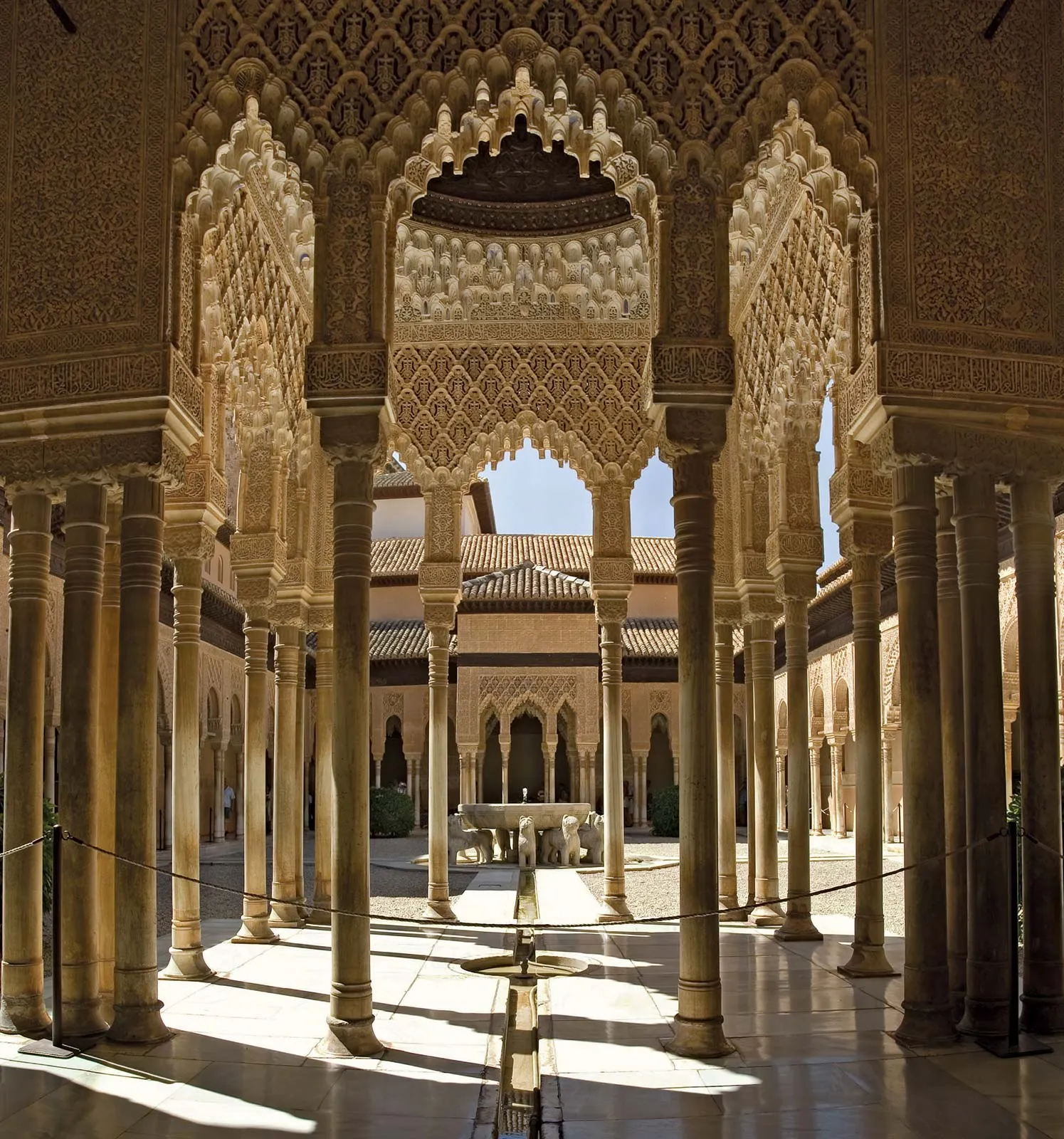
Introduction
The Alhambra, located on the Sabika Hill overlooking the city of Granada, Spain, is a majestic palace-fortress complex that stands as one of the finest examples of Islamic architecture in Europe. Built primarily during the Nasrid Dynasty in the 13th and 14th centuries, the Alhambra fuses intricate artistry, military strategy, and spiritual symbolism.
A visit to the Alhambra is not only a journey through Spain’s Islamic past but also a visual and emotional encounter with geometry, water, light, and poetry. Among its many breathtaking elements, the Court of the Lions stands out as a true masterpiece of Nasrid design.
In this article, we will delve deep into the architecture, significance, and cultural symbolism of the Alhambra, with a focused spotlight on its crown jewel — the Court of the Lions.
🏰 A Brief History of the Alhambra
The word Alhambra is derived from the Arabic "Al-Qal‘a al-Hamra", meaning "The Red Fortress", due to the reddish hue of the surrounding walls and towers. The site initially served as a modest fortress as early as the 9th century, but it wasn’t until the Nasrid Dynasty (1238–1492) that it evolved into a palatial city.
The last Muslim dynasty in Spain, the Nasrids, under rulers like Muhammad I and Muhammad V, built, expanded, and beautified the Alhambra to serve as their royal residence and administrative center.
Following the Christian Reconquista in 1492, the Alhambra was taken over by the Catholic Monarchs, and later by Charles V, who added Renaissance elements. Despite some modifications, the Islamic heart of the palace remains stunningly preserved.
🧱 Nasrid Architecture: A Legacy in Stone, Stucco, and Light
Nasrid architecture, the style in which the Alhambra was built, is defined by delicate ornamentation, refined proportions, and the symbolic use of space.
Key Features of Nasrid Design:
Stucco decoration: Intricately carved arabesques, floral motifs, and Quranic inscriptions cover almost every inch of the walls.
Geometric symmetry: Patterns, tiles, and proportions are mathematically designed to create visual harmony and spiritual balance.
Calligraphy: Walls are often lined with Arabic inscriptions, including poetry, religious verses, and royal mottos such as “Wa la ghalib illa Allah” (“There is no victor but God”).
Use of water: Fountains, pools, and channels are essential design elements, reflecting paradise as described in Islamic cosmology.
Light and shadow: Carefully placed openings and lattice screens manipulate natural light, creating an ethereal glow within the halls and courtyards.
Intricate Nasrid stucco work and Arabic calligraphy
🦁 Court of the Lions: The Heart of Alhambra
At the center of the Palacio de los Leones (Palace of the Lions) lies the Court of the Lions, arguably the most iconic and most photographed part of the Alhambra. Built during the reign of Muhammad V in the second half of the 14th century, this courtyard is an architectural embodiment of Nasrid ideals.
What Makes the Court of the Lions So Special?
🏛️ Architectural Layout
The rectangular courtyard is surrounded by 124 white marble columns, forming elegant porticoes with filigree arches.
In the center stands the Fountain of the Lions, supported by 12 intricately carved marble lions.
Four channels flow from the fountain in a cross-shaped pattern, symbolizing the four rivers of paradise.
💧 Water as a Symbol of Life and Eternity
Water here is not merely decorative; it flows continuously and silently, creating a peaceful atmosphere. The sound of water, combined with the whisper of wind and shifting light, makes this space feel timeless and almost sacred.
🐾 The Lions Themselves
Each of the twelve marble lions has a unique facial expression, an unusual touch in Islamic art, which generally avoids animal and human figures. Some scholars believe they may represent the 12 tribes of Israel, while others see them as astrological or mythological symbols.
The famous Fountain of the Lions with 12 marble lions, symbolizing power and purity
📜 Inscriptions and Poetry
One of the most captivating elements of this courtyard is the Arabic poetry inscribed along the walls. Many of these verses were written by the famous poet Ibn Zamrak, praising the beauty of the palace and glorifying its patrons.
🧭 Visitor Tips for Experiencing the Court of the Lions
If you're planning to visit the Alhambra, here are some tips for making the most of your time at the Court of the Lions:
Book tickets early – Access to the Nasrid Palaces is time-restricted and tickets sell out quickly.
Arrive early in the morning or late afternoon – These times offer the best lighting for photos and fewer crowds.
Use an official guide – Understanding the history and symbolism enhances the experience significantly.
Respect preservation rules – Touching walls or climbing structures is prohibited to protect delicate surfaces.
🌍 Cultural Significance & UNESCO Status
The Alhambra is more than a tourist destination — it is a testament to the coexistence and conflict between Islamic and Christian civilizations. After the fall of Granada, the site was preserved rather than destroyed, offering a rare glimpse into medieval Islamic life in Europe.
In 1984, the Alhambra, along with the Generalife gardens and the Albayzín district, was declared a UNESCO World Heritage Site. It is now one of the most visited monuments in Spain, attracting over 2.7 million visitors annually.
✨ Conclusion
The Alhambra’s Court of the Lions is not just a courtyard — it is a microcosm of Nasrid philosophy, where art, science, faith, and nature merge into architectural poetry. It embodies the finest Islamic craftsmanship ever produced in Europe and continues to inspire architects, artists, and travelers alike.
Whether you're an art enthusiast, history lover, or casual tourist, the Alhambra is a must-see destination that offers a sensory and intellectual journey into the golden age of Al-Andalus.

You must be logged in to post a comment.